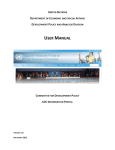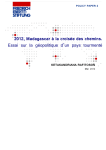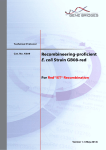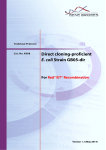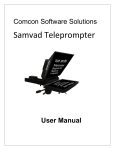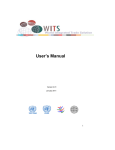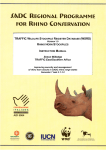Download WTO AGREEMENT ON TRADE RELATED INTELLECTUAL
Transcript
WTO AGREEMENT ON TRADE RELATED INTELLECTUAL PROPERTY RIGHTS (TRIPS) A User’s Guide Trade and Development Studies Issue No. 17 Produced by M. Masiiwa Trade and Development Centre Trust (TRADES CENTRE) Harare, Zimbabwe January 2002 Friedrich-Ebert-Stiftung Department for Development Policy - Dialogue on Globalization Hiroshimastr. 17 10785 Berlin Tel.:0049-30-26936-914 Fax: 0049-30-26935-959 [email protected] www.fes.de/globalization The opinions expressed in this paper do not necessarily reflect the views of the Friedrich-Ebert- Stiftung or the organisations for which the author works. 02/04/ 03 17: 18 Published by: Friedrich-Ebert Stiftung 6 Ross Avenue Belgravia P.O. Box 4720 Harare Trades Centre 3 Downie Avenue Belgravia Harare [email protected] http://www.fes.co.zw [email protected] http://www.tradescentre.org.zw 2 TABLE OF CONTENT ABREVIATIONS FOREWORD 1. INTRODUCTION TO WTO 2. AGREEMENT ON TRADE RELATED INTELECTUAL PROPERTY RIGHTS (TRIPS) 2.1 Introduction 2.2 What is TRIPS 2.3 Forms of Intellectual Property Rights 2.3.1 Patents 2.3.2 Copyrights 2.3.3 Trademarks 2.3.4 Geographical Indicatio ns 2.3.5 Industrial Designs 2.3.6 Layout-Designs of Integrated Circuits 2.3.7 Undisclosed Information 2.4 Implications of TRIPS on Small Scale Farmers in Africa 2.4.1 South-North Flow of Resources due to Ownership Disparity 2.4.2 Increased Marginalisation 2.4.3 Increased Dependency on Trans -National Companies (TNCs) 2.4.4 High Prices for Agricultural Inputs 2.4.5 Reduced Market Access 2.4.6 Inequitable Compensation of Knowledge 2.4.7 Increased Bio -piracy 2.4.8 Reduction of FDI, Technology Transfer and Increased Brain Drain 3. Conclusion REFERENCES 3 ABBREVIATIONS FTA HIV/AIDS ILO IMF IPRs LDC OECD SADC SAP TRIPs UNCTAD WB WTO Free Trade Area Human Immune Virus International Labour Organisation International Monetary Fund Intellectual Property Rights Least Developed Country Organisation for Economic Co-operation and Development Southern African Development Community Structural Adjustment Programmes Trade Related Intellectual Property Rights United Nations Conference for Trade and Development World Bank World Trade Organisation 4 1. FOREWORD Countries in the world are increasingly dependent on globalisation, in particular the World Trade Organisation (WTO) for economic survival, Agreements signed in these forums have far reaching effects on developing countries, particularly the marginalised groups such as smallholder farmers, the informal sectors and women. .At present, however, not every member of WTO is enjoying benefits, some countries, particularly those in Africa find it hard to derive any befits for its people. Global trade is not as smooth as assumed by the WTO. Developing countries are calling for more emphasis on fair than free trade. Trade and Development Centre Trust (TRADES CENTRE) is a non governmental and non profit making organisation involved in studies, training and trade policy dialogue in the context of globalisation, NorthSouth co-operation and regional integration. The Centre has taken this initiative to make a study on the roles of Non State Actors in regional integration within the framework of COMESA and SADC. The study also identifies issues of focus by the non-state actors so that the regional integration process in Africa can achieve its declared goafs of poverty reduction and eradication. The Friedrich-Ebert-Sftiftung (FES), is a German NGO, which is deeply involved in the issue of globalisation and regional integration through research and facilitation of dialogue. The foundation thus jointly conducted this study with Trades Centre with the aim of creating more database on WTO agreements and their implications for the benefit of policy makers and other stakeholders in Africa. It-is our sincere hope that this publication is useful to its intended target group (stakeholders in trade policy) and will add value-to the discussion on regional trade policy Dr. Moses Tekere Director - TRADES CENTRE Dr. Felix Schmidt Director - FES, Harare 5 1. INTRODUCTION TO WORLD TRADE ORGANISATION (WTO) WTO is a multilateral agreement among countries, providing a forum for negotiating trade concessions and removing of trade barriers, monitoring the multilateral trade system and developing a rule based trading system. Basic WTO principles can be summarised as non discriminatory, free movement of goods and services, predictability, competition and help ing less developed countries. The World Trade Organisation (WTO) was created on 1 January 1995 when it replaced the (General Agreement on Trade and Tariffs (GATT). GATT emerged from the abortive idea of creating an International Trade Organisation (ITO); an envisaged UN specialised organisation to exist along World Bank and International Monetary Fund (IMF). ITO was set up initially to restore world economic order after the second world war (Jones and Whittingham, 1998). ITO failed after its charter (the Havana Charter, which covered the disciplines of employment, commodity agreements and restrictive business practices) was rejected by the US Congress. After the rejection, 50 members who drew up the Havana Charter decided to negotiate to reduce and bind customs tariffs hence the formation of General Agreement on trade and Tariffs (GATT). GATT was all about the negotiation of the reduction and binding of customs tariffs. Currently, the WTO has a membership of 143 countries, China and Taiwan being the most recent members. About 80 % of the members are developing countries. There are 33 observers, who are negotiating for membership, notable ones being Russia and other former Soviet States. Other organisations such as Organisation for Economic Co-operation and Development (OECD) and several UN agencies, including UNCTAD, the World Bank and the IMF are observers to the general council. WTO Agreements are divided in the three categories of goods, services and Intellectual Property rights (TRIPS). 2. AGREEMENT ON TRADE RELATED INTELLECTUAL PROPERTY RIGHTS (TRIPS) 2.1 Introduction An Intellectual Property is the creation of human mind or human intellect. It can be a product or a process. A poetry or a design of a dress for instance are intellectual properties. Intellectual Property Rights (IPRs) are exclusive rights conferred to Intellectual Property producers and owners. Producers of intellectual creations deserve legal protection so that there is enough incentives for creativity and adequate returns. 2.2 What is TRIPS? TRIPS is the abbreviation for Trade - Related Aspects of Intellectual Property Rights. It is the WTO Agreement that lay out standards for the protection of intellectual property rights as well as set procedures and remedies for their enforcement-Article 27.3(b) of TRIPS commits all member states to introduce patents for microorganisms, and either patents or "an effective sm generis system" of protection for plant varieties. This has practical consequences almost exclusively for developing countries, because they typically retain exclusions for living organisms in their patent legislation, and usually do not have plant breeder's rights (PBR)-type legislation for plant varieties. Article 27.3{b) also stipulates that a review of the provision should be undertaken before the end of 1999. The developed countries, led by the US, argue that the review should be one of implementation. The developing countries, on the other hand, are of the view that the review is one of substance and have called for substantive changes to the TRIPS agreement in connection with this review. 2.3 Forms of Intellectual Property Rights 2.3.1 Patents A patent relates to scientific and technological innovations in various industrial and service sectors. By registering a patent government confers certain exclusive rights on the patent holder regarding the subject of the patent. A patentable product should meet any one of the following criteria; * be new * should not have been invented by someone earlier 6 * involve an inventive step i.e. should not obvious * be capable of industrial application 2.3.2 Copyrights Copy rights relate to the rights of creators of literary, scientific and artistic works. They cover performing artists in their performances, the rights of producers of phonograms [i.e. sound recordings] in their phonograms and the rights of broadcasting organisations in their radio and television programs. They have the rights to authorise or prohibit the use of the above 2.3.3 Trademarks Article 15 of TRIPS defines a trademark as "any sign or combination of signs capable to distinguish goods and services of any undertaking from those of other undertaking". The initial registration must be for a maximum period of 7 years The renewal will also be for the same period and there is no limit to the number of times it is renewed. A trademark confers the following rights: * A trademark holder has the right to prevent any person from using identical or similar signs for identical or similar goods * A trademark holder has the right to assign the trademark with or without the transfer of the business to which the trademark belongs. * Compulsory licensing cannot be made for a trademark. 2.3.4 Geographical Indications Geographical indications identify a product as originating in a particular place to which its quality, reputation and other characteristics are essentially attributable. They inform the consumer that a good has the quality reputation or other characteristics 'essential attributable to its geographical origin'. This is particularly relevant in the case of wines and spirits i.e. Champagne [which is not a trademark but a region in France] or Scotch whisky etc. The agreement provides that members will prevent the use of designation or presentation of a product which indicates that the product originates in a place different from where it actually originates therefore misleading the public as to the true geographical origin. 2.3.5 Industrial Designs Industrial design refers to the features concerning the look of-an article e.g. the shape, ornamentation, pattern, configuration etc. The TRIPS agreement imposes an obligation on its member countries to protect industrial designs that are new or original. 2.3.6 Layout-Designs of Integrated Circuits To qualify for protection under TRIPs, layout-designs have to be original. Reproduction of the protected layoutdesign, importing and selling or otherwise distributing for commercial purposes undertaken without the authorization of the rights-holder is considered unlawful Those persons who might have purchased such a product without knowledge of illegality are free from legal consequences, but they must pay royalty to the rights-holder. There are however some exceptions to the right of protection: for example the acts of reproduction for private purposes or for evaluation, analysis, research and training, etc. The term of protection of layout designs of integrated circuits is 10 years from the date of filing application for registration or for first commercial exploitation in the world. 2.3.7 Undisclosed Information Trade secrets and other types of "undisclosed information" which have commercial value must be protected against breach of confidence and other acts contrary to honest commercial practices. TRIPS agreement thus provides for the protection of undisclosed information. The requirement is that such information should have a commercial value, and the person having the information has taken steps to keep it a secret. The importance of agriculture for WTO members was further highlighte d at the Doha Ministerial Conference of-9 - 14 November 2001 (see box 1). 7 Box 1: Doha Declaration on Trade -Related Aspects of Intellectual Property Rights We stress the importance we attach to implementation and interpretation of the Agreement on TradeRelated Aspects on Intellectual Property Rights (TRIPS Agreement) in a manner supportive of public health, by promoting both access to existing medicines and research and development into new medicines and, in this connection, are adopting a separate Declaration. With a view to completing the work started in the council for Trade-Related Aspects of Intellectual Property Rights (Council for TRIPS) on the implementation of Article 23.4, we agree to negotiate the establishment of multilateral system of notification and registration of geographical indications for wines and spirits by the Fifth Session of the Ministerial Conference. We note that issues related to the extension of the protection of geographical indications provided for in Article 23 .to products other than wines and spirits will be addressed in the Council for TRIPS pursuant to paragraph 12 of this Declaration. We instruct the Council for TRIPS, in pursuing its work programme including under the review of Article 27.3(b), the review of the implementation of the TRIPS Agreement under Article 71.1 and the work foreseen to paragraph 12 of this declaration, to examine, inter alia, the relationship between the TRIPS Agreement and the Convention of Biological Diversity, the protection of traditional knowledge and folklore, and other relevant new developments raised by Members pursuant to Article 71.1. In undertaking this work, the TRIPS Council shall be guided by the objectives and principles set out in Articles 7 and 8 of the TRIPS Agreement and shall take fully into account the development dimension. 2.4 Implications of TRIPS on Small Scale Farmers in Africa The patent system was initially intended for mechanical and non-living inventions. Up to this period there was not so much worry regarding their use. Now, IPRs (particularly patents) are be used in the context of biological resources and living organisms. This is worrysome because it affects food and health supply systems for people and animals. A point of contention about TRIPS Agreement is that it protects of "formal innovation" in developed countries whilst giving little protection to "informal innovation" to developing countries. Although developing countries have shown clear opposition to the concept of IPRs over life, developed countries are adamant that this concept is even good for the developing countries themselves. By continued opposition implementation of TRIPS, developing countries risk being taken to the dispute settlement body of the WTO. With no other option left, developing countries should rather address the challenge of finding the means of TRIPS implementation that is consistent with their developmental policy and objectives. Reasons for Concern by Africa 1. Man can now isolate and manipulate genes, can claim ownership of such and use the claim for commercial gain. This has resulted in the growth and expansion of the biotechnology industry. 2. There is a growing market for biological or genetic resources for use in the biotechnology, pharmaceutical, cosmetics, agriculture and other industries. This market has led to a rise in bioprospecting activities in developing countries and, 3. There is provision in the WTO Agreement on Trade-Related Aspects of Intellectual Property Rights (TRIPS), which requires member countries of the World Trade Organisation (WTO) to patent living organisms. 8 2.4.1 South - North Flow of Resources due to Ownership Disparity The vast majority of'world patents' are filed and held by companies based in North America, Western Europe or Japan (see figure 1). Only 3% of world patents are owned by inventors in the developing countries (UNDP, 1999). Figure 1: Origins of Patents in % (1990-1995) DCs Rest EU 3% 4% 19% Japan 37% Source: Third World Network. 2000 A survey of the biotechnology patents showed that between 1990-1995, around 25,000 patents were grartted throughout the world. 37% of these originated in the US, a similar percentage from Japan, whilst 19% were from the European Union. The remaining 7% of patents came from the 'rest of the world', including all of the developing countries (Third World Network. 2000). 2.4.2 Increased Marginalisation 'Life Sciences' Industry is dominated by Trans-National Corporations (TNCs), who are predominantly from developed countries and are after profits. African countries are reduced to passive observers. The threat of further marginalisation is real. IPRs function as a tool to stop the gradual erosion of the developed countries' supremacy in manufacture and technology through imitation (or reverse) technology by developing countries. It must be noted that Japan and other Asian countries rose through the use of imitation technology. The monopoly rights granted by IPRs are thus a tool to ensure US and EU technological supremacy 2.4.3 Increased Dependency oh Trans -National Companies (TNCs) During the past decade, these TNCs have made significant investments in the research and development of biotechnology. Results of the investments are now being employed commercially in various sectors, such as the pharmaceutical, chemicals, agriculture and food industries. In order to use the technology, farmers in Africa have got to apply for licences to the patent owners and pay royalties. 2.4.4 High Prices for Agricultural Inputs The monopoly arising from the patent protection could also lead to increases in the prices of patented products, and the patent royalty payments, to the detriment of small scale farmers and consumers. Pharmaceuticals is a case in point, as has been demonstrated in AIDS patients in Africa. Here deserving 9 patients are being denied access to drug treatments due to the high cost of AIDS treatment. In another example, where agricultural land is needed for planting patented genetically engineered crops, developing countries risk being mere suppliers of land and their farmers, the contract workers of foreign patent-holders (as has happened to US farmers planting Monsanto seeds), while the bulk of the profits accrue to the patent-holders. 2.4.5 Reduced Market Access To maximise the returns from their investments, the private sector use IPRs as the means to establish monopolistic ownership over the technologies, thus allowing them to control the market share of food products using their technology. In order to seek political backing at international level, TNCs, have since the the mid-1990s heavily lobbied their governments to push for patents on living organisms within the context ofWTO. In feet, the framework and initial drafts of TRIPS were drawn up by a coalition of industry organisations from the USA, Europe and Japan, led by the US pharmaceutical industry (The Economist magazine, 1992). 2.4.6 Inequitable Compensation of Knowledge TRIPS only rewards patent owners from the north at the expense indigenous and local communities in the south. Besides categorising them under the sui generis system, TRIPS does not address the problem of distinction between creativity of indigenous peoples and local communities and that of corporate interests, - gap between source materials and end producers; - gap between producers and users. The agreement clearly segregates in terms rewarding the creativity of indigenous peoples and local communities vis-a-vis the creativity of corporate interests. Only the latter are accorded value and reward. TRIPS also stands in conflict to the Convention on Biological Diversity (CBD). The CBD vests sovereignty over natural resources and the right to grant access to genetic resources to national governments. The knowledge, innovations and practices of indigenous and local communities are considered key to the conservation, and sustainable use of biodiversity. The convention commits governments to: • respect, preserve and maintain these elements • protect customary use of bio-resources • act according to national law to develop and use traditional and indigenous technologies • adopt economically and socially sound measures that act as incentives for the conservation and sustainable use of components of biological diversity 2.4.7. Increased Bio -piracy Communities in the south will also face increased Die -piracy by TNCs from the North. Corporate interests of the North Jnvadf the local commons of the South, freely tap its biological diversity for source materials. They classify any 'improvement' or modification to them as an 'invention', and then claim intellectual property rights over the end product. This inequity threatens the viability of knowledge systems of indigenous peoples and local communities. And serious repercussions flow from this. For it is this knowledge that has fed, healed and clothed the world and continues to do so. It is estimated, for example, that three-quarters of the plants that provide active ingredients for prescription drugs came to the attention of researchers because of their use in traditional medicine.1 Of the 120 active compounds currently isolated from the higher plants and widely used in modern medicine today, 75% show a positive correlation between their modern therapeutic use and the traditional use of the plant from which they were derived. The current value of the world market for medicinal plants derived from leads given by indigenous peoples and local communities is estimated to be US$43 billion 3 The value of crop varieties improved and developed by traditional farmers to the international seed industry is estimated to be US$15 billion. 10 2.4.8 Reduction of FDI, Technology Transfer and increased 'Brain Drain' By enforcing a strict IPR regime, developed countries argue that developing countries are likely to benefit through increased Foreign Direct Investment (FDI) and technology transfer. It is further debated that flows of FDI and technology into developing countries, will result in an increase in the resources for research and development (R&D) by local researchers and companies. The patents system will also promote domestic innovation, by providing incentives for locaf researchers and inventors. However, strict IPR regimes could restrict domestic R&D. In fact, the lack of IPR protection in countries such as Switzerland, Japan and some Asian countries is cited as a key factor that allowed for technological catching-up of these countries (Gerster, 1998). The initial absence of strict IPR protection in these countries provided the opportunity to progress and to acquire basic technology through imitation and reverse engineering. The advancements made were then followed by largely domestic investments in R&D. Strict IPR 'regimes may also encourage foreign companies to simply export finished or semi-finished products, since only their patented products could legally be marketed, precluding production by domestic companies. 4. CONCLUSION The TRIPS Agreement has far reaching effects on developing countries, particularly the marginalised groups such as smallholder farmers, the informal sectors and women. This agreement is highly skewed in favour of developed countries. Firstly, there is a real risk that more financial resources will flow from the south to the north as developing countries pay for licences and royalties for companies in developed countries. More than 95% of patents on biological patents are held in developed countries. There is also a larger risk of food insecurity in African countries because the TRIPS agreement mean that farmers in developing countries will largely depend on TNCs in developed countries for seeds, chemicals and other inputs. It is vital that the imbalance that exists in WTO leadership be resolved. It a challenge for African countries to take opportunities offered by globalisation and at the same time push for measures that mitigate negative effects on its people in WTO, e.g. the unfair provisions of TRIPS. 11 REFERENCES Evans, P. and Walsh J.; The EIU Guide to World Trade under the WTO. Economist intelligent Unit, London, 1995 FES Seminar Proceedings Series 43: ACP-EU Cotonou Agreement: What are the Options and Challenges for SADC Lai Das, B. An introduction to the WTO Agreements, UNCTAG, 1998 Masiiwa, M; The regulation of agricultural trade under WTO, Friedrich-EbertStiftung/Trades Centre, Harare, 2002 Muuka, N.G., Harrison, D. E., McCoy J, P.; Impediments to Economic Integration in Africa: The Case of COMES A in Journal of business in developing nations volume 2 (1998), article 3 Nomvete, B. D. (1993). Regional Integration in Africa: A path strewn with Obstacles. The Courier, November-December, pp. 49-55. Tandon, T. LDC's Reject A New Round for Doha: in FES Seminar Proceedings 52; WTO: From Seattle to Doha (Qatar); What is at Stake for SADC, Harare, 2001 Tekere, M. The New ACP-EU [Cotonou] Agreement: User's Guide, Part 3; The Trade Provisions of the New Agreement United Nations Development Programme; Human Development Report 2001, New York, 2001 World Bank. (1994). Adjustment in Africa: Reforms, Results, and the Road Ahead. World Bank, Washington, DC. World Trade Organisation Web-site: http://www.wto.org 12 TRADE AND DEVELOPMENT STUDIES CENTRE TRUST (TRADES CENTRE) We are pleased to inform our long standing and prospective partners about the formal establishment of Trade and Development Studies Centre Trust [TRADES CENTRE] formerly known as Lome Trade Research Unit [LOTRU] as an independent research and training centre incorporated and registered with the Heeds Register in Zimbabwe. It is a non-profit making organisation controlled by a Board of Trustees whose members are eminent persons drawn from various sectors in southern Africa. Our Vision., The economic renaissance of southern Africa and its poor communities in the Third Millennium will more than ever before depend on the impact of current fundamental global changes in the international, regional and national trading policy regimes being driven by the momentum of technological revolution, information technology and the neo-liberal philosophy, yet in the same region this problem issue is not subjected to assiduous close scrutiny. The aim is to establish a rigorous, consistent and ongoing programme on trade and development policy research, analysis and capacity building on ACP-EU co-operation, EU-SADC trade relations, US-SADC trade [AGOA], WTO, national trade and development issues. TRADES CENTRE'S vision is to develop into a southern Africa regional Centre of excellence on policy research, analysis and civil society capacity building on trade and development issues. 0ur Objectives. The main objective of Trade and Development Studies Centre is policy-relevant training and research particularly focusing on the nexus between trade and development, aid and development, poverty reduction and welfare improvement in the context of WTO, post Lome IV ACP-EU cooperation, COMESA/SADC-EU co-operation, the SA-EU trade and development co-operation agreement, US-SADC [AGOA] trade, regional trade/economic agreements and national trade and development policies. A central objective of TRADES CENTRE is to provide southern Africa with technical, analytical support in developing and backstopping their positions in multilateral and interregional trade negotiations and support regional integration. TRADES CENTRE will also strive to build the capacity of poor communities on trade issues in order to assist them in meeting challenges posed by emerging trade regimes. Our Approach. TRADES Centre aims to undertake practical, realistic, concrete and technically competent research work and training of civil society that produce feasible and implementable results taking into account the circumstances existing on the ground, Like its predecessor [LOTRU], the TRADES CENTRE will adopt both a demand driven and a proactive approach in bringing up issues that affect its target group. Our bias. TRADES CENTRE is biased in favour of developing countries in particular southern Africa and its poor communities. Our aim is to analyse trade and development issues from the perspectives of southern Africa's poor communities, to explore the implications of the various international, regional and bilateral trade agreements, regional integration, national trade and development policies and other policy options on southern Africa for the poor. Our Target Groups . Consumers of the results of the work of TRADES CENTRE include small scale farmers, consumer and faith groups, workers unions, informal traders, policy makers, parliamentarians, business (.•(immunity, NGOs and donor community, (t is therefore the objective of" TRADES CENTRE to improve the capacity of its target group to engage and interpret policy issues and decisions as they impact on the poor. Resources. The main resource for the TRADES CENTRE is its pool of professionals and expertise within its permanent establishment, associated members and international experts and consultants committed to working in support of TRADES CENTRE vision. It receives financial support from various donor agencies and also generates resources from its own activities with no profit motive. Deliverables. The results of the TRADES CENTRE activities will timeously be delivered and made publicly available through conferences, seminars and workshops for the target groups, briefing materials, publications, circulation in mass media, training programs and tutorials.. Philosophy, Generation and delivery of quality products timely. Practical, realistic research and training easily accessible and implementable and which produces concrete policy proposals aimed at improving the welfare of poor people and communities in southern Africa. 13 In its efforts to meet its objectives and deliver results TRADES CENTRE values the support by you and your organisation and we look forward to close co-operation in-future. We welcome partnerships including funding. Dr Moses Tekere: Director and on Behalf of the Board of Trustees 14
















